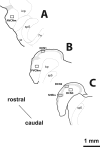Cochlear damage changes the distribution of vesicular glutamate transporters associated with auditory and nonauditory inputs to the cochlear nucleus
- PMID: 19339615
- PMCID: PMC4487620
- DOI: 10.1523/JNEUROSCI.0208-09.2009
Cochlear damage changes the distribution of vesicular glutamate transporters associated with auditory and nonauditory inputs to the cochlear nucleus
Abstract
Integration of multimodal information is essential for understanding complex environments. In the auditory system, multisensory integration first occurs in the cochlear nucleus (CN), where auditory nerve and somatosensory pathways converge (Shore, 2005). A unique feature of multisensory neurons is their propensity to receive cross-modal compensation after deafening. Based on our findings that the vesicular glutamate transporters, VGLUT1 and VGLUT2, are differentially associated with auditory nerve and somatosensory inputs to the CN, respectively (Zhou et al., 2007), we examined their relative distributions after unilateral deafening. After unilateral intracochlear injections of kanamycin (1 and 2 weeks), VGLUT1 immunoreactivity (ir) in the magnocellular CN ipsilateral to the cochlear damage was significantly decreased, whereas VGLUT2-ir in regions that receive nonauditory input was significantly increased 2 weeks after deafening. The pathway-specific amplification of VGLUT2 expression in the CN suggests that, in compensatory response to deafening, the nonauditory influence on CN is significantly enhanced. One undesirable consequence of enhanced glutamatergic inputs could be the increased spontaneous rates in CN neurons that occur after hearing loss and that have been proposed as correlates of the phantom auditory sensations commonly called tinnitus.
Figures






Similar articles
-
Glutamatergic Projections to the Cochlear Nucleus are Redistributed in Tinnitus.Neuroscience. 2018 Nov 1;391:91-103. doi: 10.1016/j.neuroscience.2018.09.008. Epub 2018 Sep 18. Neuroscience. 2018. PMID: 30236972 Free PMC article.
-
Altered vesicular glutamate transporter distributions in the mouse cochlear nucleus following cochlear insult.Neuroscience. 2016 Feb 19;315:114-24. doi: 10.1016/j.neuroscience.2015.12.009. Epub 2015 Dec 17. Neuroscience. 2016. PMID: 26705736 Free PMC article.
-
Somatosensory projections to cochlear nucleus are upregulated after unilateral deafness.J Neurosci. 2012 Nov 7;32(45):15791-801. doi: 10.1523/JNEUROSCI.2598-12.2012. J Neurosci. 2012. PMID: 23136418 Free PMC article.
-
Cross-modal interactions of auditory and somatic inputs in the brainstem and midbrain and their imbalance in tinnitus and deafness.Am J Audiol. 2008 Dec;17(2):S193-209. doi: 10.1044/1059-0889(2008/07-0045). Am J Audiol. 2008. PMID: 19056923 Free PMC article. Review.
-
VGLUT1 and VGLUT2 mRNA expression in the primate auditory pathway.Hear Res. 2011 Apr;274(1-2):129-41. doi: 10.1016/j.heares.2010.11.001. Epub 2010 Nov 24. Hear Res. 2011. PMID: 21111036 Free PMC article. Review.
Cited by
-
Tinnitus: Maladaptive auditory-somatosensory plasticity.Hear Res. 2016 Apr;334:20-9. doi: 10.1016/j.heares.2015.06.005. Epub 2015 Jun 12. Hear Res. 2016. PMID: 26074307 Free PMC article. Review.
-
Glutamatergic Projections to the Cochlear Nucleus are Redistributed in Tinnitus.Neuroscience. 2018 Nov 1;391:91-103. doi: 10.1016/j.neuroscience.2018.09.008. Epub 2018 Sep 18. Neuroscience. 2018. PMID: 30236972 Free PMC article.
-
A Neural "Tuning Curve" for Multisensory Experience and Cognitive-Perceptual Schizotypy.Schizophr Bull. 2017 Jul 1;43(4):801-813. doi: 10.1093/schbul/sbw174. Schizophr Bull. 2017. PMID: 28168302 Free PMC article.
-
Decoding tinnitus progression: neurochemical shifts in the anterior cingulate cortex revealed by magnetic resonance spectroscopy.Front Neurosci. 2025 Feb 27;19:1551106. doi: 10.3389/fnins.2025.1551106. eCollection 2025. Front Neurosci. 2025. PMID: 40084135 Free PMC article.
-
Somatosensory inputs modify auditory spike timing in dorsal cochlear nucleus principal cells.Eur J Neurosci. 2011 Feb;33(3):409-20. doi: 10.1111/j.1460-9568.2010.07547.x. Epub 2010 Dec 29. Eur J Neurosci. 2011. PMID: 21198989 Free PMC article.
References
-
- Alibardi L. Mossy fibers in granule cell areas of the rat dorsal cochlear nucleus from intrinsic and extrinsic origin innervate unipolar brush cell glomeruli. J Submicrosc Cytol Pathol. 2004;36:193–210. - PubMed
-
- Babalian AL. Synaptic influences of pontine nuclei on cochlear nucleus cells. Exp Brain Res. 2005;167:451–457. - PubMed
-
- Batzri-Izraeli R, Kelly JB, Glendenning KK, Masterton RB, Wollberg Z. Auditory cortex of the long-eared hedgehog (Hemiechinus auritus). I. Boundaries and frequency representation. Brain Behav Evol. 1990;36:237–248. - PubMed
-
- Bauer CA, Brozoski TJ, Myers K. Primary afferent dendrite degeneration as a cause of tinnitus. J Neurosci Res. 2007;85:1489–1498. - PubMed
Publication types
MeSH terms
Substances
Grants and funding
LinkOut - more resources
Full Text Sources
Other Literature Sources
Medical
